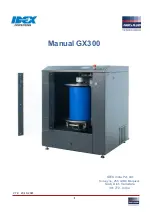
12
EURORACK MX602A
2) Generate a signal, i.e. a voice through a microphone. There should now be some activity at the bargraph
meters
.
3) For mic channels: Adjust the gain control
until transient peaks are regularly h6 dB. Continuous
signals should not exceed 0 dB.
4) For stereo channels and other stereo line inputs, use the output volume of the source instrument or FX unit
to effect gain adjustment until transient peaks are regularly h6 dB. Continuous signals should not
exceed 0 dB.
5) Altering EQ will affect a channel’s gain. If EQ is adjusted at any time, repeat steps 2 and 3 or 4.
6) Turn the channel’s volume control fully counter-clockwise. Move onto next channel and repeat steps 1
thru 6.
7) Once all channel inputs have been set for level, turn all active channel level controls back to 0 dB. You are
now ready to start mixing.
7.4 Desk normalization
All board settings should be set to the normal default condition before or after every session. Usually volumes
are set to zero (minus infinity), EQs set flat, and Aux Sends turned fully counter-clockwise etc.
7.5 Recording levels
When recording to digital, it’s a good idea to keep the recorder’s peak meters below 0 dB. Most (not all, esp.
samplers) read 0 dB with some headroom left. This is because, unlike with analogue, the onset of digital
distortion is as sudden as it is horrible. If you really want to take your recording level to the limit (and fully
exploit 16-bit digital’s 96 dB dynamic range for example), you’ll have to do some calibrating. How to do it? Well,
you could run a tone at 0 dB from the mixer and use that as your DAT or ADAT reference. But your DAT or
ADAT may be way under its maximum input limit. Probably a better way to work out just how hard you can
drive your recorder is to incrementally increase the record level until the onset of digital distortion, subtract,
say, 5 or 10 dB, and never exceed that level. Engage “peak hold” on your recorder before recording if you want
to confirm that you haven’t. Peak meters read more-or-less independent of frequency. Aim for 0 dB recording
level for all signals.
7. SETTING UP


































